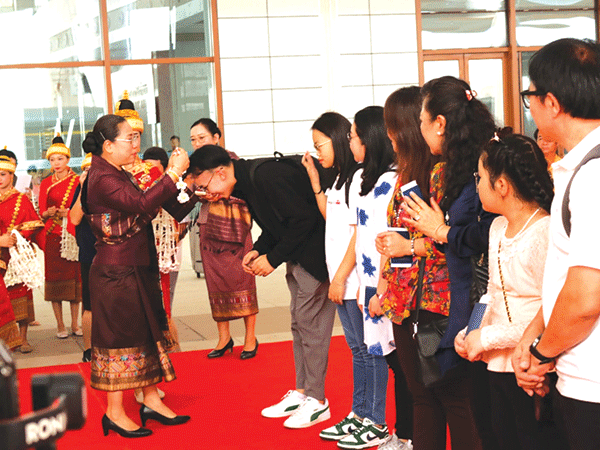Historic cross-border passenger trains travel between Vientiane and Kunming
The first train (named Lane Xang) making a direct journey from Vientiane to Kunming in China on the Laos-China railway left the Lao capital on Thursday morning.
The launch of the direct cross-border service took place in Vientiane and at the Boten border checkpoint in Luang Namtha province, attended by Minister of Information, Culture and Tourism, Mrs Suanesavanh Vignaket, deputy ministers and other guests.
Speaking at the ceremony, Mrs Suanesavanh said “Today’s ceremony is an important historical event in the cooperation between the governments of
 |
| Minister of Information, Culture and Tourism, Mrs Suanesavanh Vignaket, officials and guests on Thursday attend a ceremony to mark the start of cross-border passenger trains between Laos and China. |
Laos and China, which always encourage and help each other to bring strength and prosperity to their countries.
The first train to run between Vientiane and Kunming in China marks a great leap forward in the provision of transport links and the promotion of tourism, she said.
The Laos-China railway is a cooperation project that has the full support of the leaders of the two government and is a symbol of Laos-China friendship in the modern era.
The railway constitutes a strategic part of the Lao government’s plan to transform the landlocked country into a land link within the region, helping to fulfil the dreams and aspirations of the Lao people for greater regional integration.
This railway was built as part of the “One Belt, One Road” initiative instigated by China’s President Xi Jinping.
“Both our countries must continue to strive to achieve high-quality development and continuously upgrade our cooperation to take it to a higher level,” Mrs Suanesavanh said.
The aim of the Lao government is to turn the Laos-China railway into an economic corridor that generates substantial income for Laos, helping to ease the current woeful economic situation and bring more foreign tourists to the country.
The railway serves to raise the profile of Laos in the international arena, by integrating passenger transport services with those of neighbouring countries and strengthening Laos’ tourism links with countries in the region and beyond.
The vital transport link provided by the railway has the potential to place Laos at the centre of efforts to more closely link Asean countries to China.
Following the lifting of Covid-related travel restrictions, countries around the world have set programmes in motion to revive their economies, especially by promoting tourism, with a particular focus on visitors from China, who have the greatest purchasing power.
In 2019, before the Covid-19 pandemic hit the following year, more than one million Chinese tourists came to Laos, accounting for 21 percent of the total number of visitors.
Last year, even though the Chinese government had yet to open its borders for outbound tourism, more than 45,000 Chinese tourists came to Laos from third countries.
“The high-speed train link between Laos and China offers huge potential for the growth of international travel. Today is a landmark occasion in pursuit of this goal as Laos and China jointly launch a high-speed cross-border passenger train service connecting Vientiane to Kunming, enabling many more tourists to visit the two countries,” Mrs Suanesavanh said.
The minister also attended a send-off ceremony for the first passengers making the direct journey from Laos to China and welcomed passengers arriving in Laos on the train from China.
The journey between Vientiane and Kunming covers a distance of 1,035 kilometres, stopping at eight stations, with a total travel time of 10 hours and 30 minutes. This includes the time taken to go through immigration at the Boten-Bohan border crossing.
Rail operators in both countries began selling tickets for seats on cross-border trains at 8am on April 11.
A first-class seat on the EMU train from Vientiane to Kunming costs 1,901,000 kip, while a second-class ticket is priced at 1,192,000 kip.
Two trains will run each day, with one departing from Vientiane and the other leaving from Kunming.
Train No. D887 will depart Kunming South Station at 7:08am (Lao time) and arrive in Vientiane at 5:38pm on the same day.
In the other direction, Train No. D888 will depart Vientiane at 8:08am (Lao time) and arrive at Kunming South Station at 6:38pm on the same day.
Passengers travelling from Kunming to Vientiane must get off the train with their belongings when it reaches the border at Mohan in China. They will then undergo document checks at immigration booths.
After the checks have been completed, passengers can reboard the train and continue their journey.
When the train arrives on the other side of the border at Boten in Laos, passengers must again get off the train with their belongings for a second immigration check.
Passengers whose final destination is Boten can leave the station at this point, while passengers travelling to other stations in Laos can continue their journey.
Each immigration check will take about 90 minutes, meaning the total time taken to complete exit and entry procedures in both China and Laos is about three hours in total.
By Times Reporters
(Latest Update April 19, 2023)
|